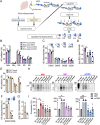Neuronal Ndst1 depletion accelerates prion protein clearance and slows neurodegeneration in prion infection
- PMID: 37747931
- PMCID: PMC10586673
- DOI: 10.1371/journal.ppat.1011487
Neuronal Ndst1 depletion accelerates prion protein clearance and slows neurodegeneration in prion infection
Abstract
Select prion diseases are characterized by widespread cerebral plaque-like deposits of amyloid fibrils enriched in heparan sulfate (HS), a abundant extracellular matrix component. HS facilitates fibril formation in vitro, yet how HS impacts fibrillar plaque growth within the brain is unclear. Here we found that prion-bound HS chains are highly sulfated, and that the sulfation is essential for accelerating prion conversion in vitro. Using conditional knockout mice to deplete the HS sulfation enzyme, Ndst1 (N-deacetylase / N-sulfotransferase) from neurons or astrocytes, we investigated how reducing HS sulfation impacts survival and prion aggregate distribution during a prion infection. Neuronal Ndst1-depleted mice survived longer and showed fewer and smaller parenchymal plaques, shorter fibrils, and increased vascular amyloid, consistent with enhanced aggregate transit toward perivascular drainage channels. The prolonged survival was strain-dependent, affecting mice infected with extracellular, plaque-forming, but not membrane bound, prions. Live PET imaging revealed rapid clearance of recombinant prion protein monomers into the CSF of neuronal Ndst1- deficient mice, neuronal, further suggesting that HS sulfate groups hinder transit of extracellular prion protein monomers. Our results directly show how a host cofactor slows the spread of prion protein through the extracellular space and identify an enzyme to target to facilitate aggregate clearance.
Copyright: This is an open access article, free of all copyright, and may be freely reproduced, distributed, transmitted, modified, built upon, or otherwise used by anyone for any lawful purpose. The work is made available under the Creative Commons CC0 public domain dedication.
Conflict of interest statement
I have read the journal’s policy and the authors of this manuscript have the following competing interests: JJI serves as the Chair for the Scientific Advisory Board for the company Applied Cognition, Inc, from which he receives compensation and in which he holds an equity stake.
Figures




References
-
- Henderson MX, Cornblath EJ, Darwich A, Zhang B, Brown H, Gathagan RJ, et al. Spread of α-synuclein pathology through the brain connectome is modulated by selective vulnerability and predicted by network analysis. Nat Neurosci. 2019;22(8):1248–57. doi: 10.1038/s41593-019-0457-5 PMCID: PMC6662627 - DOI - PMC - PubMed
Publication types
MeSH terms
Substances
Grants and funding
LinkOut - more resources
Full Text Sources
Molecular Biology Databases

